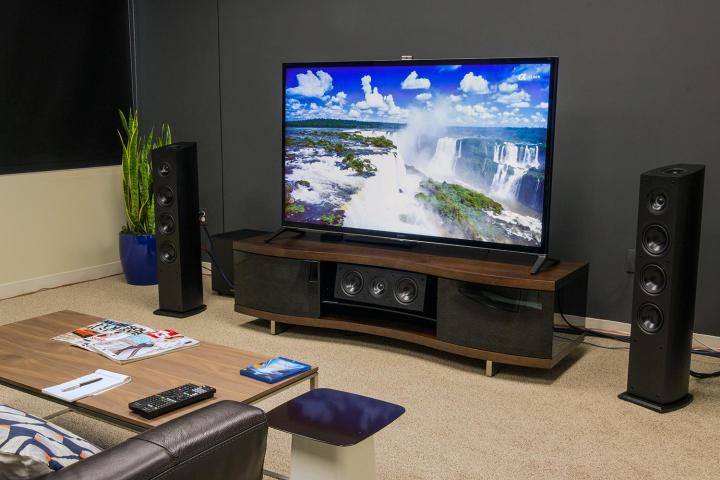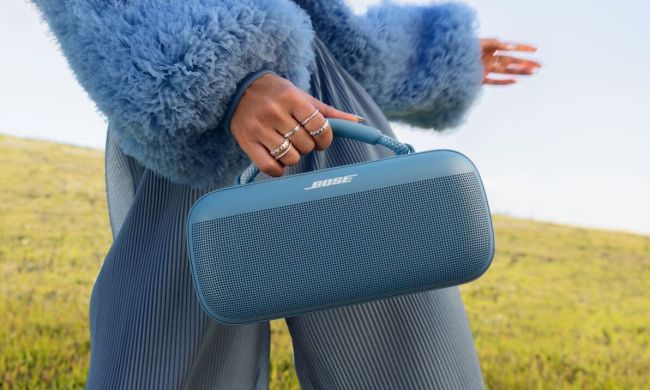Finding a sound system that perfectly balances quality and style might seem near-impossible. When looking for an audio solution, you’ll likely see two options: Soundbars and traditional home theater speakers. Deciding on the best solution can seem like an enormous challenge if you’re not sure what suits your needs the best.
Should you go with a soundbar or speakers? We’ll help you make the best decision based on a few key factors, such as room size, connectivity, and sound quality.
What is a soundbar?
A soundbar is a convenient audio solution without the overall cost of an expensive and fully immersive home theater setup. What makes soundbars convenient is that they are typically compact and sit right in front, under, or mounted above the TV. Not having to rely on a receiver, soundbars are self-contained, which makes moving them from one place to another easy.

What are traditional speakers?
This audio solution has separate components for increased sound quality. With separate speakers and an amplifier/receiver, you will typically get better surround sound effects than a soundbar. Furthermore, the setup can be customizable for any space.

Which is right for you?
Now that you have an idea of soundbars and home theater speakers, let us figure out which is more suitable for you. What you enjoy watching and the sound quality that your audio solution provides are essential. Everyone has their own unique needs when it comes to their sound experience.
Soundbars
As TVs get thinner, the speakers built into them must diminish in size as well, which in turn means that they lack robust sound quality. As we discussed in our how to buy a soundbar guide, many options on the market can deliver up to seven channels of audio, with some that include a subwoofer. Additionally, some soundbars give you the option of surround sound audio by adding more speakers and angling their output. And some premium soundbars come with Dolby Atmos technology built-in, which provides a fully immersive experience that mimics having speakers all around the room. That includes not only left, right, and center, but even up above, so you truly feel like you’re part of the action.
If you’re looking to improve sound quality beyond what your TV is capable of — without breaking the bank — a soundbar could be right for you. With a soundbar, you can explore various options, including surround soundbars, 3.1 soundbars, or 2.1 and 2.0 soundbars.
- Surround soundbars: Your surround soundbars create an immersive surround sound experience through multichannel surround sound formats. These soundbars typically support Dolby Atmos and are denoted as 5.1 or 7.1, shorthand for the number of speakers. There are center, left, and right channels usually in the bar itself, as well as two or four satellites and a dot-one (.1) for the subwoofer. If you want a soundbar that offers immersive sound quality but you have limited space, a surround soundbar is the way to go.
- 3.1 soundbars: This class of soundbar has a dedicated center channel, so if you are having a tough time hearing the voices while watching TV, a 3.1 soundbar provides that clarity for you.
- 2.1 and 2.0 soundbars: These are stereo soundbars that have a left and right channel. If you are looking to enhance your TV’s current speaker a little more without putting too much money into it, then this is the way to go. And, of course, the dot-one (.1) has a subwoofer; the dot-zero (.0) does not. A technology called surround sound virtualization means that some top-tier 2.1 soundbars can truly trick your brain into believing you hear sound from all around, making them an attractive proposition that can save space.
While soundbars were once upon a time considered to be sub-par alternatives to true home theater systems, they have been getting better and better at not only producing improved sound but also improved separation of sound. A single bar can truly make you feel as though there are actually multiple speakers in a room. But achieving this is limited to premium-priced, higher-end models.
Nonetheless, if a soundbar is right for you, our soundbar buying guide can help you out.
Traditional speakers
Traditional speakers or component audio are for someone looking to create a home theater experience with the space to accommodate it. From the receiver to rear speakers, floor speakers, and the subwoofer, traditional speakers for watching movies might be perfect for you. Furthermore, check out our ultimate surround sound guide for even more information.
With a traditional speaker system, you get a great audio experience for movies and TV shows. You can experience genuine surround sound effects with rear speakers, and the setup is very flexible. Add ceiling Atmos (or DTS:X or other similar technology) speakers, and you’ll feel like rain pouring down in the movie might tap your head or like you should duck as the hum of an airplane engine comes closer and closer. Thanks to the mix-and-match nature of these systems, you aren’t bound to any one manufacturer, and you can pick speakers and other components based on your preferences. Furthermore, you can expand and upgrade speakers and receivers as you like.
You can also buy full systems in packages or bundles. These can range from a 2.1 stereo sound system that includes just a left and right speaker along with a subwoofer — good for music listening — to as high as an 11.1 system that includes speakers on either side in the front and back, a center channel, subwoofer, and above. Specific placement will vary based on the room layout and other factors. Most commonly, however, people choose a simple stereo or 5.1 setup.
With these systems come cost and complexity in comparison to soundbars. A full speaker system setup can cost you well over $1,000, but this complexity will give you audio that rivals your local movie theater. Furthermore, your receiver for your sound system can act as an HDMI hub for your other devices — gaming consoles, HTPC, streaming devices, music from your phone, and more. If you’re not limited by space and looking for a home theater experience, then a traditional speaker setup is right for you.
The type of audio solution you go with depends on what you enjoy watching (sitcoms and news versus sports and action films, for example), the importance of audio and a fully immersive sound experience, and the room it will be located in.


![The JBL Xtreme 4 Bluetooth speaker. [Embargoed image 06/03]](https://www.digitaltrends.com/wp-content/uploads/2024/05/jbl-xtreme-4-review-in-water-o2.jpeg?resize=650%2C390&p=1)
